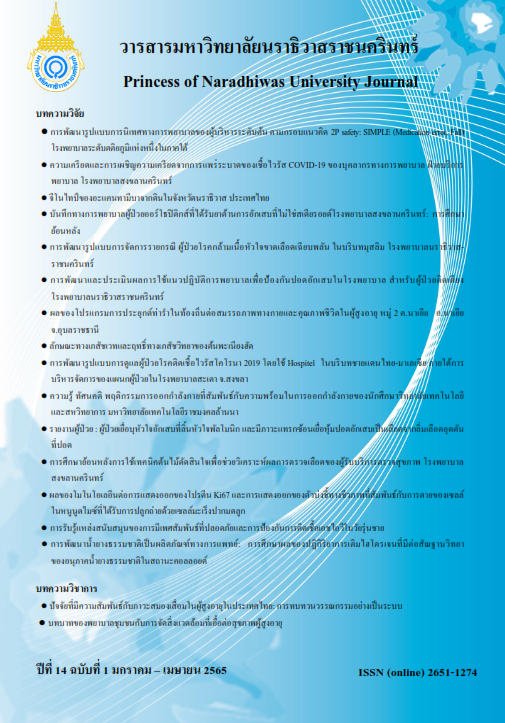Effects of Monoolein on Ki67 Protein and Apoptosis-Related Biomarkers Expression in Cervical Cancer Implanted Nude Mice
Keywords:
Monoolein, HeLa cell, Ki67, TUNEL, Caspase 3Abstract
This study aimed to investigate the effect of monoolein (MO), a glycolipid surfactant purified from Exophiala dermatitidis on expression of cell proliferation; Ki67 and apoptosis biomarkers; TUNEL and Caspase-3 in cervical cancer xenograft in nude mouse model. HeLa cells were subcutaneously injected on the right dorsal of BALB/C nude mice to establish xenografted tumors. Mice were randomly divided into 2 groups, HeLa implanted mice (HeLa group) and HeLa implanted mice treated with MO (HeLa-MO group). Monoolein 200 mg/Kg/BW was injected subcutaneously around the tumor mass for 28 days. Tumor tissue mass of each mouse was collected for immunohistochemical examination of Ki67 and for examination of apoptosis by using TUNEL and Caspase-3 assays. The result showed that MO treatment in HeLa-MO group significantly reduced the Ki67 expression by 57.53% as compared to HeLa group (66.67±6.78 and 157±10.54, cell/field, respectively). Furthermore, TUNEL and Caspase-3 staining were remarkably increased in HeLa-MO group (118.5±6.53 and 32.76±4.51 cell/field) and (130.7±11.42 and 34.2±2.49 cell/field) as compared to HeLa group, respectively (p<0.001).
In conclusion, our finding demonstrated that treatment with monoolein in cervical cancer mouse model can reduced tumor growth via inhibition of tumor cell proliferation and apoptosis pathway.
References
Bray, F., Ferlay, J., Soerjomataram, I., Siegel, R.L., Torre, L.A., & Jemal, A. (2018). Global cancer statistics 2018: GLOBOCAN estimates of incidence and mortality worldwide for 36 cancers in 185 countries. CA: A Cancer Journal for Clinicians, 68(6), 394-424.
Chung, C. (2018). Restoring the switch for cancer cell death: Targeting the apoptosis signaling pathway, Am J Health Syst Pharm, 75(13), 945-952.
ElMasrya, S.R., & Hathout R.M., (2018). In Vitro transdermal delivery of sesamol using oleic acid chemically-modified gelatin nanoparticles as a potential breast cancer medication, Journal of Drug Delivery Science and Technology, 48, 30-39.
Kitaoka, M., Oka, A., & Goto, M., (2020). Monoolein Assisted Oil-Based Transdermal Delivery of Powder Vaccine, Pharmaceutics, 12(814), 1-13.
Nakrukamphonphatn, S., Suwannakoo, N., & Natason, A., (2021). Primary Prevention Behavior for Cervical Cancer among Husbands, Regional Health Promotion Center 9 Journal, 15(38), 484-496.
Nawale, L., Dubey, P., Chaudhari, B., Sarkar, D., & Prabhune, A. (2018). Anti-proliferative effect of novel primary cetyl alcohol derived sophorolipids against human cervical cancer cells HeLa, PLOS ONE, 1-14.
Punjaruk W. (2015). Physiology of Cancer: Prospective Aspects Beyond the 21st Century, Srinagarind Med J, 30(2), 175-183.
Rongpan, S., Trongwongsa, T., Wongsatayanon, B., & Jariyapongskul, A. (2015). Effect of monoolein on inhibition of tumor growth in cervical cancer xenografts in nude mice, Journal of Medicine and Health Sciences, 22(3), 41-52.
Rongpan, S., Phonnok, S., Boondireke, S., Tripinyopap, N., & Wongsatayanon, B. (2017). Anti-Proliferative Effect of Long-Chain Monoglyceride Derivatives on Human Cervical Carcinoma Cell Line, J Med Assoc Thai, 100(Suppl. 8), S165-S172.
Ruangpratheep, C. (2019). The basic concepts of apoptosis, Royal Thai Army Medical Journal, 72(2), 137-143.
Shrestha, A.D., Neupane, D., Vedsted, P., & Kallestrup, P. (2018). Cervical Cancer Prevalence, Incidence and Mortality in Low and Middle Income Countries: A Systematic Review: Asian Pac J Cancer Prev, 19(2), 319-324.
Sukpanichnant, S. (2018). Myeloma Pathology 2017. J Hematol Transfus Med, 28(1), 71-81.
Sung, H., Ferlay, J., Siege,l R.L., Laversanne, M., Soerjomataram, I., Jemal, A., & Bray, F. (2021). Global Cancer Statistics 2020: GLOBOCAN estimates of incidence and mortality worldwide for 36 cancers in 185 countries. CA: A Cancer Journal for Clinicians, 71(3), 209–24.
Tang, X., Tao, F., Xiang, W., Zhao, Y., Jin, L., & Tao, H. (2020). Anticancer effects and the mechanism underlying 2‑methoxyestradiol in human osteosarcoma in vitro and in vivo. Oncology Letters, 20(64), 1-9.
Thammasiri, J., Navanukraw, C., Nutthakornkul, J., Guntaprom, S., & Khanthusaeng, V. (2017). Evaluation of growth and development of corpus luteum in goats using proliferating cell nuclear antigen (PCNA) and Ki-67 as markers of cell proliferation, KHON KAEN AGR. J, 45, 1746-752
Wu, Y.S., Ngai, S.C., Goh, B.H., Chan, K.G., Lee, L.H., & Chuah, L.H. (2017). Anticancer Activities of Surfactin and Potential Application of Nanotechnology Assisted Surfactin Delivery. Frontiers in Pharmacology, 8(761), 1-22.
Yoon, B.K., Jackman, J.A., Elba Valle-Gonzalez, R., & Cho, N.J. (2018). Antibacterial Free Fatty Acids and Monoglycerides: Biological Activities, Experimental Testing, and Therapeutic Applications, International Journal of Molecular Sciences, 19(1114), 1-40.
Downloads
Published
How to Cite
Issue
Section
License
Copyright (c) 2022 Princess of Naradhiwas University Journal

This work is licensed under a Creative Commons Attribution-NonCommercial-NoDerivatives 4.0 International License.




